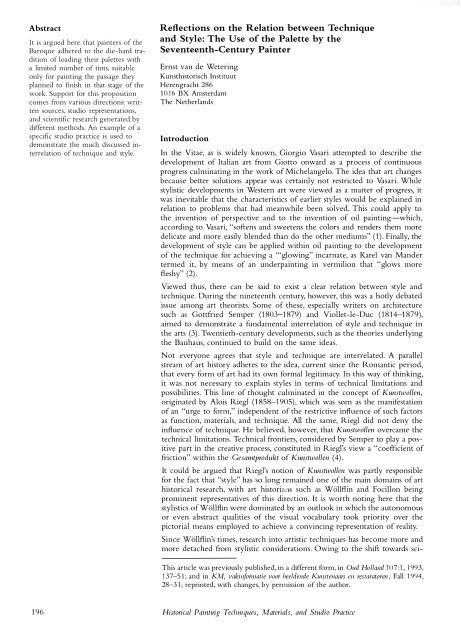Historical Painting Techniques, Materials, and Studio Practice
You also want an ePaper? Increase the reach of your titles
YUMPU automatically turns print PDFs into web optimized ePapers that Google loves.
Abstract<br />
It is argued here that painters of the<br />
Baroque adhered to the die-hard tradition<br />
of loading their palettes with<br />
a limited number of tints, suitable<br />
only for painting the passage they<br />
planned to finish in that stage of the<br />
work. Support for this proposition<br />
comes from various directions: written<br />
sources, studio representations,<br />
<strong>and</strong> scientific research generated by<br />
different methods. An example of a<br />
specific studio practice is used to<br />
demonstrate the much discussed interrelation<br />
of technique <strong>and</strong> style.<br />
Reflections on the Relation between Te chnique<br />
<strong>and</strong> Style: The Use of the Palette by the<br />
Seventeenth-Century Painter<br />
Ernst van de Wetering<br />
Kunsthistorisch Instituut<br />
Herengracht 286<br />
1016 BX Amsterdam<br />
The Netherl<strong>and</strong>s<br />
Introduction<br />
In the Vitae, as is widely known, Giorgio Vasari attempted to describe the<br />
development of Italian art from Giotto onward as a process of continuous<br />
progress culminating in the work of Michelangelo. The idea that art changes<br />
because better solutions appear was certainly not restricted to Vasari. While<br />
stylistic developments in Western art were viewed as a matter of progress, it<br />
was inevitable that the characteristics of earlier styles would be explained in<br />
relation to problems that had meanwhile been solved. This could apply to<br />
the invention of perspective <strong>and</strong> to the invention of oil painting-which,<br />
according to Vasari, "softens <strong>and</strong> sweetens the colors <strong>and</strong> renders them more<br />
delicate <strong>and</strong> more easily blended than do the other mediums" (1). Finally, the<br />
development of style can be applied within oil painting to the development<br />
of the technique fo r achieving a "'glowing" incarnate, as Karel van M<strong>and</strong>er<br />
termed it, by means of an underpainting in vermilion that "glows more<br />
fleshy" (2).<br />
Viewed thus, there can be said to exist a clear relation between style <strong>and</strong><br />
technique. During the nineteenth century, however, this was a hotly debated<br />
issue among art theorists. Some of these, especially writers on architecture<br />
such as Gottfried Semper (1803-1 879) <strong>and</strong> Viol1et-le-Duc (1814-1 879),<br />
aimed to demonstrate a fu ndamental interrelation of style <strong>and</strong> technique in<br />
the arts (3). Twentieth-century developments, such as the theories underlying<br />
the Bauhaus, continued to build on the same ideas.<br />
Not everyone agrees that style <strong>and</strong> technique are interrelated. A parallel<br />
stream of art history adheres to the idea, current since the Romantic period,<br />
that every fo rm of art had its own fo rmal legitimacy. In this way of thinking,<br />
it was not necessary to explain styles in terms of technical limitations <strong>and</strong><br />
possibilities. This line of thought culminated in the concept of Kunstwollen,<br />
originated by Alois Riegl (1858-1 905), which was seen as the manifestation<br />
of an "urge to fo rm," independent of the restrictive influence of such factors<br />
as function, materials, <strong>and</strong> technique. All the same, Riegl did not deny the<br />
influence of technique. He believed, however, that Kunstwollen overcame the<br />
technical limitations. Technical frontiers, considered by Semper to play a positive<br />
part in the creative process, constituted in Riegl's view a "coefficient of<br />
friction" within the Gesamtprodukt of Kunstwollen (4).<br />
It could be argued that Riegl's notion of Kunstwollen was partly responsible<br />
for the fact that "style" has so long remained one of the main domains of art<br />
historical research, with art historians such as Wollflin <strong>and</strong> Focillon being<br />
prominent representatives of this direction. It is worth noting here that the<br />
stylistics ofWollflin were dominated by an outlook in which the autonomous<br />
or even abstract qualities of the visual vocabulary took priority over the<br />
pictorial means employed to achieve a convincing representation of reality.<br />
Since Wollflin's times, research into artistic techniques has become more <strong>and</strong><br />
more detached from stylistic considerations. Owing to the shift towards sci-<br />
This article was previously published, in a different form, in Oud Holl<strong>and</strong> 107: 1, 1993,<br />
137-51; <strong>and</strong> in KM, vakil'!for111atie voor beeldende Kunstenaars en res fa rato ren, Fall 1994,<br />
28-31; reprinted, with changes, by permission of the author.<br />
196<br />
<strong>Historical</strong> <strong>Painting</strong> <strong>Techniques</strong>, <strong>Materials</strong>, <strong>and</strong> <strong>Studio</strong> <strong>Practice</strong>


